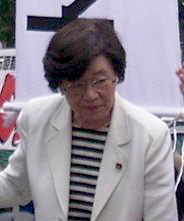Takako Doi facts for kids
Quick facts for kids
Takako Doi
|
|
|---|---|
 |
|
| Speaker of the House of Representatives of Japan | |
| In office August 6, 1993 – September 27, 1996 |
|
| Monarch | Akihito |
| Deputy | Hyōsuke Kujiraoka |
| Preceded by | Yoshio Sakurauchi |
| Succeeded by | Sōichirō Itō |
| Chairwoman of the Social Democratic Party | |
| In office 9 September 1986 – 31 July 1991 |
|
| Preceded by | Masashi Ishibashi |
| Succeeded by | Makoto Tanabe |
| In office 28 September 1996 – 15 November 2003 |
|
| Preceded by | Tomiichi Murayama |
| Succeeded by | Mizuho Fukushima |
| Member of the House of Representatives | |
| In office 27 December 1969 – 11 September 2005 |
|
| Personal details | |
| Born | November 30, 1928 Kobe, Hyōgo, Empire of Japan |
| Died | September 20, 2014 (aged 85) Hyogo Prefecture, Japan |
| Political party | Japanese Socialist Party, Social Democratic Party |
Takako Doi (born November 30, 1928 – died September 20, 2014) was an important Japanese politician. She was active in politics from 1980 until 2005. Takako Doi made history as the first woman to become the Speaker of the House of Representatives in Japan. This was the highest political job a woman had held in modern Japan. She was also the country's first female leader of an opposition party.
Contents
Biography
Early Life and Career
Takako Doi was born in Hyōgo Prefecture, Japan. She went to Doshisha University and studied law there. In 1969, she was elected to the House of Representatives. This is the lower house of Japan's parliament, called the Diet. She represented a district in Hyōgo.
For her first ten years in the House, she was not widely known. But in 1980, she became famous for speaking out. She strongly criticized how women were treated unfairly in Japan. For example, she spoke about degrees only for women in home economics. She also challenged family laws that favored fathers. She pushed the Diet to sign an important agreement in 1985. This agreement was the Convention on the Elimination of All Forms of Discrimination Against Women (CEDAW). It aims to stop all forms of unfair treatment against women.
Rising in Politics
In 1983, Doi became the Vice Chair of the Japan Socialist Party (JSP). Then, in 1986, she became the first female leader of a political party division in Japan. She led the JSP Central Policy Division. Her popularity helped the JSP win many seats in 1990. They won 136 seats in the House of Representatives, which was a record for them. However, she left her party leadership role in 1991 after the Gulf War.
In 1994, no single party had enough seats to control the House. So, the JSP helped form a new government with other parties. The JSP's president, Tomiichi Murayama, became the Prime Minister. But this government did not last long. It broke apart in 1996. After a very bad election for the JSP that year, Takako Doi returned to lead the party again.
Party Leadership and Challenges
Takako Doi was well-liked as a politician who opposed the government. But when she became the party leader, her party faced difficulties. Her main action as leader was to change the JSP's name. In 1996, it became the Social Democratic Party (SDP). She said she wanted to make the party more moderate. She also wanted to bring more women into politics. Doi helped bring young women, like Kiyomi Tsujimoto, into the party. These women had experience working for change in their communities.
In 1998, some former JSP members and others formed the Democratic Party of Japan. The SDP then became a smaller opposition party. Its number of members in parliament kept going down. By 2003, the SDP was a very minor party. Around this time, the truth about Japanese citizens kidnapped by North Korea became clear. Takako Doi's public image suffered greatly. This was because of her earlier comments about the kidnapped families. She had also made a comment in 1987 in Pyongyang about North Korea's leader at the time. Doi apologized to the families. She said that North Korean officials had tricked her. She then resigned from her party leadership role.
Leaving Parliament
Takako Doi lost her seat in the House of Representatives in the 2003 election. However, she still stayed in the House. This was because she won a seat through a different system, called proportional representation. But in the 2005 elections, she lost this seat too. After that, she retired from politics.
Death
Takako Doi passed away on September 20, 2014. She was 85 years old. She died in a hospital in Hyogo Prefecture from pneumonia.
See also
 In Spanish: Takako Doi para niños
In Spanish: Takako Doi para niños

